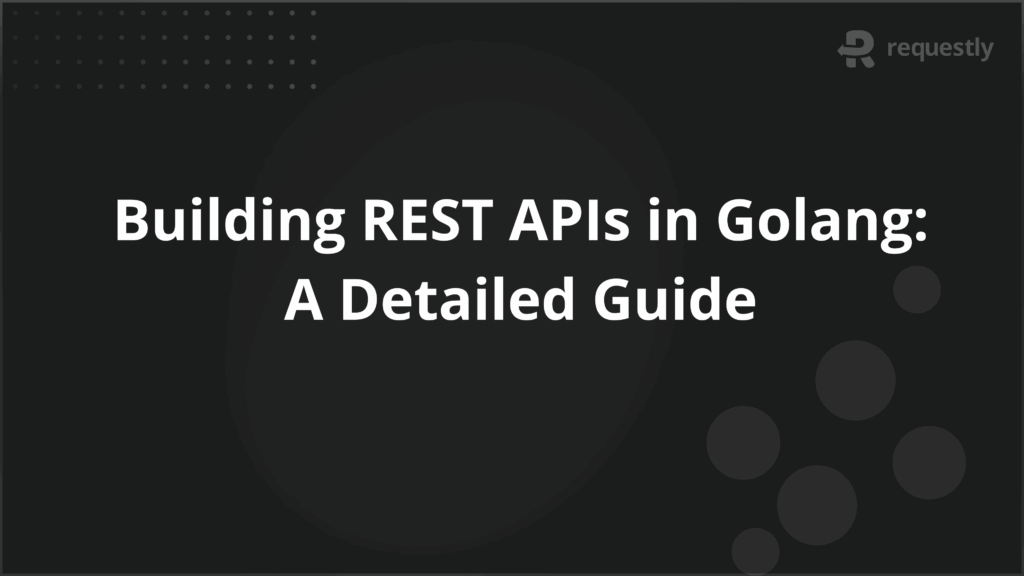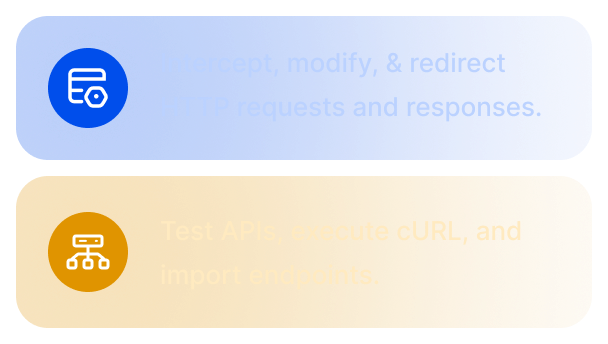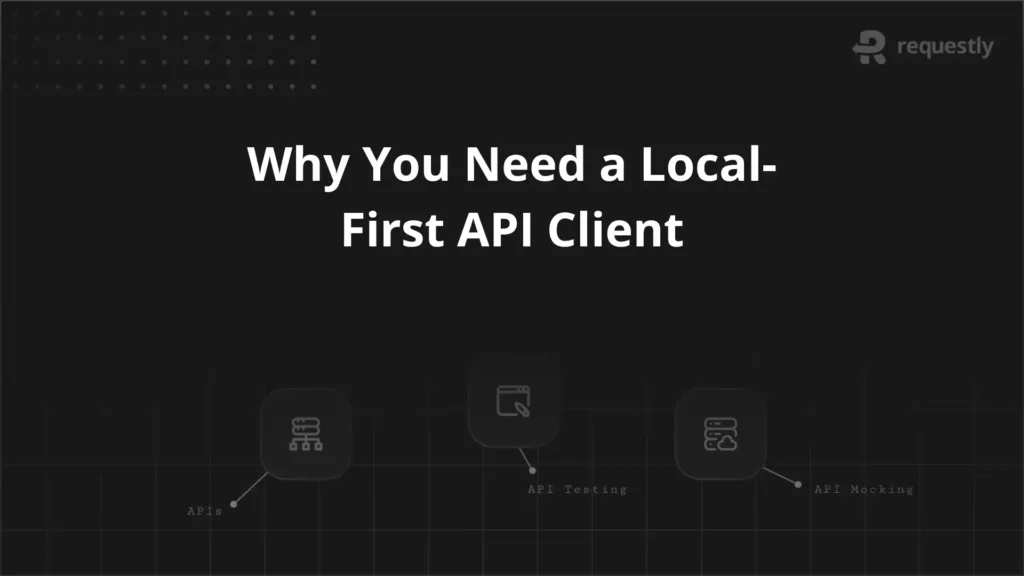Building REST APIs in Golang: A Detailed Guide


REST APIs have become the backbone of modern web applications. Their simplicity, scalability, and ease of integration make them an ideal choice for backend communication.
Golang (or Go), with its performance-oriented architecture and native concurrency support, is increasingly favored by developers for building reliable and scalable RESTful services.
This article explains how to build REST APIs using Golang and everything you need to know about it.
What is a REST API?
A REST (Representational State Transfer) API is a set of rules and conventions used to build web services that allow communication between different systems over HTTP. It is an architectural style for designing networked applications, making it easy to use and understand.
REST APIs rely on standard HTTP methods (GET, POST, PUT, DELETE, etc.) to perform operations on resources. These resources are typically represented as URLs and are manipulated through these methods, often returning data in formats like JSON or XML.
Key characteristics of a REST API include:
- Stateless: Each request from a client to a server must contain all the information necessary to understand and process the request. The server does not store any state between requests.
- Client-Server Architecture: The client (usually a web or mobile application) interacts with the server through HTTP requests. The client and server are separate entities, each responsible for different tasks.
- Cacheable: Responses from the server can be explicitly marked as cacheable or non-cacheable, which improves performance by reducing the need for repeated data retrieval.
- Uniform Interface: A standardized set of conventions for communication between client and server. This simplifies interaction and enables easy integration between different systems.
- Resource-Based: In REST, every resource (such as a user, product, or blog post) is identified by a unique URL and can be manipulated through HTTP methods.
REST APIs are widely used due to their simplicity, scalability, and ease of integration with web services, making them a popular choice for modern web applications.
What is Golang?
Golang, or Go, is an open-source programming language developed by Google. It was designed to address the limitations of other languages, providing a combination of simplicity, efficiency, and scalability.
Go is statically typed, compiled, and focuses on minimalism in syntax, making it easy to learn and maintain. It excels in building high-performance backend systems, distributed applications, and microservices.
Key features of Go include:
- Simplicity: Go’s syntax is clean and minimal, avoiding complex features like inheritance or generics to keep code straightforward.
- Performance: Being a compiled language, Go is fast and efficient, suitable for building high-performance applications.
- Concurrency: Go’s goroutines and channels make managing multiple tasks concurrently simple, ideal for scalable systems.
- Garbage Collection: Go handles memory management automatically, reducing the risk of memory leaks.
- Cross-Platform: Go programs are easily compiled to run on multiple operating systems without dependencies.
Go is widely used in cloud computing, microservices, and tools like Docker and Kubernetes, thanks to its speed, simplicity, and concurrency features.
Why Choose Golang to Build REST API?
Golang provides several advantages for REST API development:
- High Performance: Compiled language with minimal memory overhead and fast execution time.
- Concurrency Support: Built-in goroutines and channels simplify handling multiple simultaneous requests.
- Simplicity and Readability: Go’s minimal syntax improves code readability and maintainability.
- Rich Standard Library: Includes comprehensive packages for HTTP, I/O, encoding, etc.
- Cross-Platform Compilation: Single binary compilation allows easy deployment.
Prerequisites for Building REST APIs in Go
Before starting, ensure the following:
- Basic knowledge of Go syntax and standard library
- Go installed on your machine (preferably the latest stable version)
- Familiarity with REST principles and HTTP methods
- Experience with JSON and basic database operations (SQL or NoSQL)
- Tools: Postman or curl for API testing, and Git for version control
Project Setup and Directory Structure
Organizing your project is key to scalability and maintainability. A common structure:
bash
/go-rest-api
/cmd
/app
main.go
/internal
/handler
/model
/repository
/service
/middleware
/pkg
/config
/docs
go.mod
- cmd/app: Application entry point
- internal/: Core logic grouped by functionality
- pkg/: Reusable utility packages
- config/: Configuration files
- docs/: OpenAPI specs or other documentation
Choosing the Right HTTP Router (Standard Library vs. Third-Party)
When building REST APIs in Go, selecting the right HTTP router is crucial for performance, flexibility, and ease of use. While Go’s standard library offers a solid foundation for routing, third-party routers provide additional features that can streamline development and handle complex routing needs more efficiently.
Standard Library (net/http)
The standard net/http package provides basic HTTP functionalities, including a router that can be used to handle requests.
- Lightweight: Being part of Go’s core library, it requires no external dependencies.
- Built-In: Since it’s included with Go, there’s no need to install additional packages, making it a minimalistic option.
- Verbose Routing: The router functionality is simple but lacks advanced features like path parameters, request middleware, or grouped routes. Developers often need to write more boilerplate code to implement these features, which can become cumbersome in larger applications.
The standard library is ideal for smaller applications or those with simpler routing needs. However, for more complex routing structures, third-party routers are often more efficient and scalable.
Third-Party Routers
- Gorilla Mux:
- Known for its advanced routing capabilities, such as URL parameters, regular expressions, and route variables. It also supports middlewares and request validation.
- Ideal for developers who need flexible routing features without compromising on performance.
- Chi:
- Lightweight and idiomatic, Chi is designed for fast, simple, and efficient routing. It provides a minimalistic API but with excellent support for middleware, nested routes, and context-based routing.
- It’s perfect for applications that prioritize simplicity but also need scalability in their routing architecture.
- Gin:
- A high-performance web framework that focuses on speed. It’s built for developers who need maximum performance and scalability, with built-in features like routing, middleware, JSON validation, and much more.
- Gin is ideal for handling high-throughput applications with complex routing needs.
When choosing between the standard library and third-party routers, consider your project’s complexity and performance requirements. For simple, lightweight applications, Go’s standard library is enough. But for more complex routing and better performance with features like middleware and parameterized routes, a third-party router like Gorilla Mux, Chi, or Gin is often a better fit.
Designing API Endpoints and Data Models
Designing clear, intuitive, and RESTful endpoints is crucial for building maintainable and scalable APIs. Proper endpoint design improves both the developer and user experience, and helps ensure that the API is easy to integrate with other services.
Designing RESTful Endpoints
RESTful APIs typically operate around resources. Each resource is uniquely identified via a URL, and standard HTTP methods are used to interact with them.
Example of standard API endpoints:
pgsql
GET /users // Retrieves a list of all users
GET /users/{id} // Retrieves a specific user by ID
POST /users // Creates a new user
PUT /users/{id} // Updates an existing user by ID
DELETE /users/{id} // Deletes a user by ID
Each of these routes is designed to reflect the underlying operations on a resource, following REST conventions for resource names and methods.
Defining Data Models in Go
Go structs are used to define the data models, which will be serialized to and from JSON. This is achieved using struct tags to map fields to JSON keys.
Example struct definition for a User model:
go
type User struct {
ID int `json:"id"`
Name string `json:"name"`
Email string `json:"email"`
}
- Struct Tags: The json:”field” tags specify how the struct fields are mapped to JSON keys. This enables proper marshaling and unmarshaling of data between Go structures and JSON responses.
Proper endpoint and data model design lay the foundation for scalable and easy-to-understand APIs.
Implementing CRUD Operations
CRUD operations (Create, Read, Update, Delete) form the core of most REST APIs. These operations are typically mapped to HTTP methods: POST, GET, PUT, and DELETE, respectively.
Implementing CRUD in Go
Each HTTP method should map to an appropriate handler that performs the corresponding database operation. Here’s an example of implementing the GET /users endpoint:
go
func GetUsers(w http.ResponseWriter, r *http.Request) {
users := []User{{ID: 1, Name: "Alice", Email: "alice@example.com"}}
w.Header().Set("Content-Type", "application/json")
json.NewEncoder(w).Encode(users)
}
- HTTP Methods:
- GET for fetching resources.
- POST for creating a new resource.
- PUT for updating an entire resource.
- DELETE for removing a resource.
- Status Codes: Each CRUD operation should return the appropriate HTTP status code to indicate success or failure (e.g., 200 OK, 201 Created, 400 Bad Request, 404 Not Found).
Effective implementation of CRUD operations ensures your API can perform the full range of data manipulations expected from a RESTful service.
Working with JSON in Go
JSON is the de facto standard for data exchange in REST APIs. Go’s encoding/json package provides the necessary tools for encoding and decoding JSON data.
Encoding and Decoding JSON
To handle JSON requests and responses in Go, you can use the json.NewEncoder() and json.NewDecoder() functions. Here’s how:
- Encode struct to JSON:
go
json.NewEncoder(w).Encode(myStruct)
- Decode JSON to struct:
go
json.NewDecoder(r.Body).Decode(&myStruct)
- Error Handling: Always handle errors that occur during the encoding or decoding process. For example, if the JSON is malformed, you should return a 400 Bad Request response.
Proper handling of JSON ensures that data is properly formatted for both sending and receiving, making your API more robust and consistent.
Handling Requests, Responses, and Status Codes
When building REST APIs, it’s important to manage HTTP requests and responses efficiently. Proper validation, header management, and status code handling are key to building reliable APIs.
Request Validation and Parsing
Before processing a request, you should validate incoming data to ensure it meets the required format. This may include checking request headers, parameters, and body content.
Example of validating incoming JSON data:
go
var user User
err := json.NewDecoder(r.Body).Decode(&user)
if err != nil {
http.Error(w, "Invalid request body", http.StatusBadRequest)
return
}
Response Headers and Status Codes
Always set the appropriate Content-Type header in the response to indicate the data format, typically application/json for REST APIs.
Example:
go
w.Header().Set("Content-Type", "application/json")
w.WriteHeader(http.StatusOK)
Each response should include the correct HTTP status code to indicate the result of the operation. Common status codes include:
- 200 OK: Successful request
- 201 Created: Resource successfully created
- 400 Bad Request: Invalid client request
- 404 Not Found: Resource not found
- 500 Internal Server Error: Unexpected server error
Using status codes properly ensures clients can easily handle different responses and errors.
Middleware in Golang APIs (Logging, CORS, Authentication)
Middleware functions provide a way to add functionality to HTTP requests and responses, such as logging, authentication, and handling cross-origin requests.
Middleware Implementation
A middleware function takes an HTTP request and response, performs some operation, and passes control to the next handler.
Example of a simple logging middleware:
go
func LoggingMiddleware(next http.Handler) http.Handler {
return http.HandlerFunc(func(w http.ResponseWriter, r *http.Request) {
log.Printf("Request: %s %s", r.Method, r.URL.Path)
next.ServeHTTP(w, r)
})
}
Common Middleware Types
- Logging: Logs each incoming request for debugging or analytics purposes.
- CORS (Cross-Origin Resource Sharing): Ensures that your API can be accessed by web applications hosted on different domains.
- Authentication: Validates that requests have valid authentication tokens (e.g., JWT) before allowing access to protected routes.
Middleware is essential for adding functionality that needs to be applied across multiple routes without duplicating code.
Authentication and Authorization in REST APIs
Authentication and authorization are crucial components of secure REST APIs. Authentication verifies the identity of the user, while authorization ensures that the user has the appropriate permissions to access certain resources.
Authentication
- Basic Authentication: Involves sending the username and password in the request headers.
- Token-Based Authentication (JWT, OAuth2): Involves using tokens like JWT (JSON Web Token) for more secure and scalable authentication, particularly in stateless applications.
Example of JWT middleware:
go
func AuthMiddleware(next http.Handler) http.Handler {
return http.HandlerFunc(func(w http.ResponseWriter, r *http.Request) {
token := r.Header.Get("Authorization")
if !validateToken(token) {
http.Error(w, "Unauthorized", http.StatusUnauthorized)
return
}
next.ServeHTTP(w, r)
})
}
Authorization
Authorization controls access to resources based on the user’s role or permissions. This can be role-based (e.g., admin, user) or based on specific permissions.
You can implement authorization checks in middleware or directly in handlers to ensure users can only access the resources they are permitted to.
Why Choose Requestly?
When building and testing REST APIs, modifying request/response behaviors during development is crucial. Requestly allows developers to intercept, modify, and debug API traffic in real-time without modifying backend code.
Key benefits:
- Modify headers and query params instantly
- Redirect or mock API responses
- Create custom rules for development and QA testing
- Chrome and desktop app integration
Requestly simplifies debugging and testing, making API development smoother and more efficient.
Conclusion
Building REST APIs in Go is a powerful combination of simplicity, performance, and reliability. With the right architectural practices, tools, and testing strategies, Go APIs can scale seamlessly in production environments.
For optimizing API testing, debugging, and real-time modification, Requestly is the ideal tool for developers to ensure smooth operations and better overall efficiency during development.
Whether building microservices or monolithic APIs, Go offers the tools and performance needed for modern backend development.

Contents
- What is a REST API?
- What is Golang?
- Why Choose Golang to Build REST API?
- Prerequisites for Building REST APIs in Go
- Project Setup and Directory Structure
- Choosing the Right HTTP Router (Standard Library vs. Third-Party)
- Standard Library (net/http)
- Third-Party Routers
- Designing API Endpoints and Data Models
- Designing RESTful Endpoints
- Defining Data Models in Go
- Implementing CRUD Operations
- Implementing CRUD in Go
- Working with JSON in Go
- Encoding and Decoding JSON
- Handling Requests, Responses, and Status Codes
- Request Validation and Parsing
- Response Headers and Status Codes
- Middleware in Golang APIs (Logging, CORS, Authentication)
- Middleware Implementation
- Common Middleware Types
- Authentication and Authorization in REST APIs
- Authentication
- Authorization
- Why Choose Requestly?
- Conclusion
Subscribe for latest updates
Share this article
Related posts























